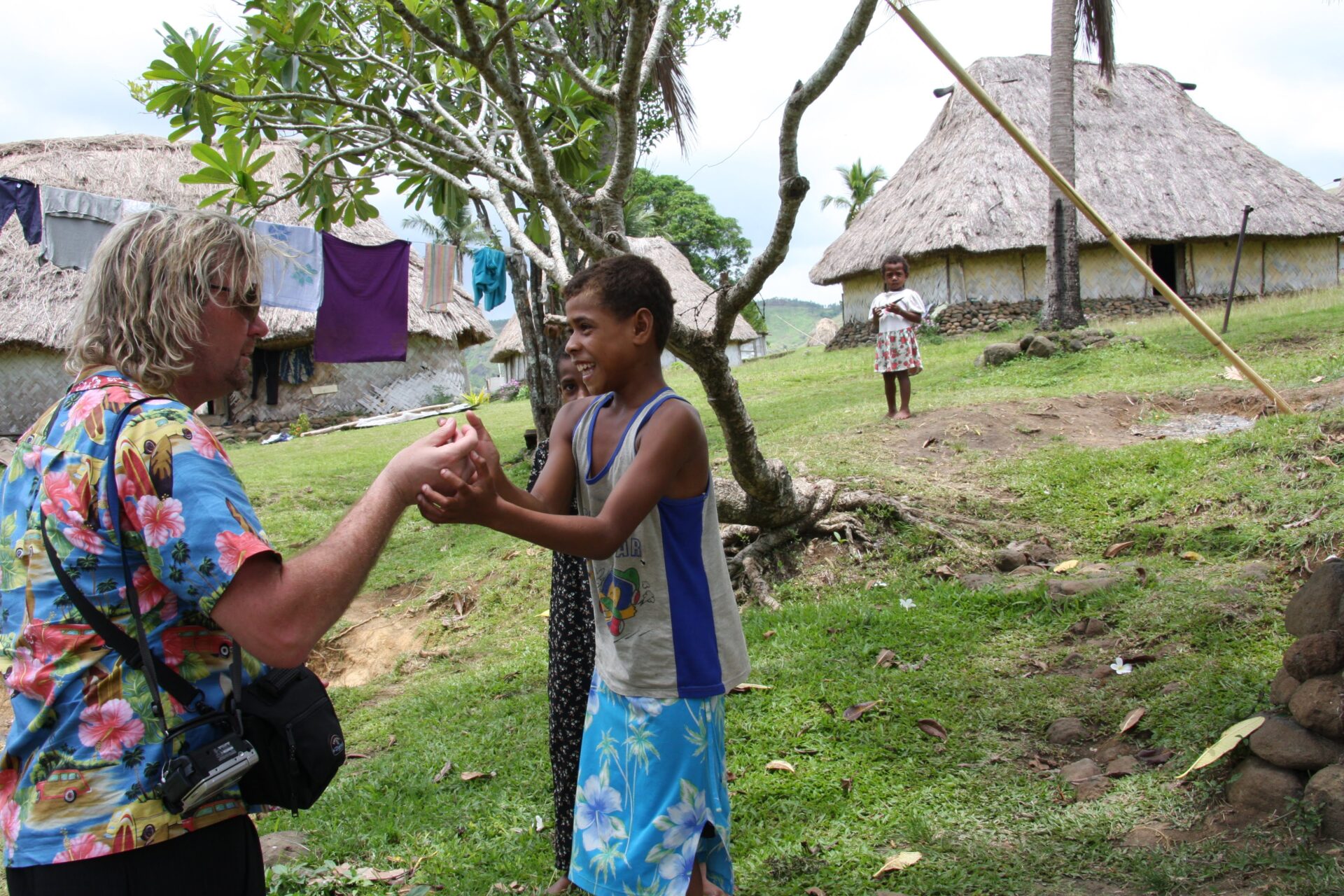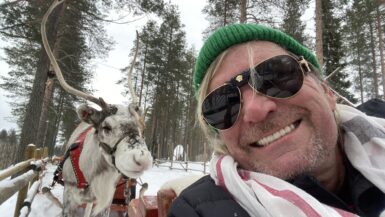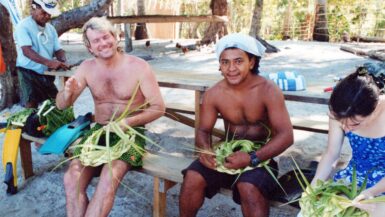I had always wondered about the mystical islands of Fiji. When you hear “Fiji”, one automatically thinks of pure drinking water, amazing beaches and the movie “Blue Lagoon”(where it was filmed). A friend of mine had asked me to help her find a deal to Fiji and after I had done a little research for her, she changed her mind and decided to go to Cancun; I had gotten so excited about what I saw, I booked it for myself. Fiji doesn’t disappoint. It’s made up of 2 main islands and countless smaller ones with high end resorts or simple huts for economy traveling.
We had spent almost a week on the main island of Viti Levu and had explored the Sigatoka sand dunes, gone bull shark diving and found lots of other fun stuff when we decided it was time to do a little island hopping. There are lots of independent tourist agents who are happy to put together an entire trip from ferries to accommodation. As we ordered some nachos from Nadi’s Hard Rock Cafe, we found an agent who put together a great package for us. We would be leaving the next day and spend a couple of nights on 3 different islands including the “Blue Lagoon” island in Yasawa. We were excited about changing up our trip a little and made sure we stayed near the ferry so we could catch our ride the next day.
The next morning our bags were packed and we were ready to go except for one detail. We needed to return the rental car to the airport. I topped off the gas tank and headed that direction. As I turned on the radio, I realized that something was definitely not right. Instead of music, there were a lot of emergency warnings and bulletins about a giant tidal wave, or tsunami that had been heading towards Fiji. According to the news, it was only 2 hours away from our island! 2 hours? Really? I couldn’t believe it!
The previous year I had traveled to Phuket, Thailand. Phuket had been hit by a tsunami almost exactly a year before my arrival. Some hotels there were still in ruin, piles of trash were still around every corner, and it took very little imagination to see what that wall of water had done to this once beautiful tourist destination. I had heard lots of stories from survivors and almost everyone of them had climbed or driven to the mountain top before it hit. The ones below were not so lucky. With this new discovery of a tidal wave heading my way, the logical choice was, get on top of a mountain!
I was just arriving at the airport and things had gotten a little crazy. I was supposed to meet my tour contact there when I returned the car and she was nowhere to be found. I saw 3 young girls with backpacks walking around looking confused. They were from Norway and had just heard about the water coming our way. They had been trying to figure out how to get on the roof of the airport. A lot of people were looking for higher ground. They begged if they could come with me. I wasn’t sure if I could squeeze them in my car and what I was going to do with them, but I agreed. I decided to keep the rental car and drive somewhere where we’d be safe from the giant waves. When I got back to the hotel to collect my girlfriend and traveling partner, Kerry, she was quite surprised to see the Norwegians, but was happy to help nonetheless.
As the minutes ticked by, I started looking on my map for a road that would get us into the interior of the country. Fiji has one continuous ring road loop but there’s not a lot of roads that take you into the mountains. I discovered a route 30 minutes north of our location. With less than one hour till impact, we got on the road. While we were driving, news poured in about some of the smaller islands that had been hit. The islands were much less inhabited and it was really difficult to understand exactly how much damage had been done and if the wave had slowed down at all. We didn’t want to take a chance so we just kept driving. As I turned east and headed into the mountains toward the Koroyanitu National Heritage area, we lost all radio signals. It was maybe 30 minutes until the tsunami was going to hit Fiji and we had no radio: just static.
The day couldn’t have been more beautiful. Like the eye of a hurricane, there was no indication that anything bad was about to happen. If the situation was similar a few decades ago, no one would have had any warning. You might be walking on the coast, admiring the scenery, when suddenly the beach water would just disappear like a tide in fast motion. Then you might see a giant wall of water rushing at you. By then it would be too late. You wouldn’t be able to outrun it as it tumbled in and knocked down buildings and trees and sucked cars into the ocean. In a few minutes, the wave would be no more , but the damage would linger for years. As we twisted through the winding dirt roads, we could see the coastline disappear as the land became more tropical and remote.
We finally came to a small traditional village. A few of these small communities have been preserved so that travelers and even other Fijians can observe the way their people used to live and learn more about their history and culture. The village was entirely made of thatched huts and it seemed as if half the town was swimming in the river that was apparently the source of water for the area. We were greeted by one of the residents and we explained that we were running away from the tsunami but no one seemed to be alarmed in the slightest. Maybe it was because they didn’t have TV or radio. Maybe it was because they knew that they were safe from the ocean’s reach. Curious kids surrounded us. I started doing magic tricks for them and they laughed and wanted me to do more. No matter where I go in the world, kids seem to love magic tricks. We were taken on a tour of the village and asked if we’d like to have lunch. It didn’t feel touristy at all, we couldn’t imagine these people accommodating tour buses, but they seemed to be able to keep us entertained for a few hours. Lunch was great except for the kava. Kava is a ceremonial drink that all Fijians love and drink religiously. It’s created from the powder of some bitter tasting bark. It’s moistened and mixed with water and strained and mixed and strained again in a round proprietary wooden vessel. It almost looks like someone washing clothes by hand. At the end of the preparation, the mixologist produces a liquid which looks like old dishwater and tastes much worse in my opinion. It’s supposed to give you a little energy boost, euphoria and other things. I could never drink more than the amount to make my mouth start feeling numb. It was difficult to refuse, but a Fiji beer is always a better option.
We asked if anyone knew anything about the damage from the tsunami. We might as well have been on another planet. No one knew anything or seemed even slightly concerned. We checked the radio again. Just static. We decided enough time had passed that we could risk heading back towards the coast. As we drove and the ocean finally came into view, we couldn’t see any abnormal waves. When we hit the coastal road, there was no damage. We turned on the radio and there was no news about the tsunami. We finally reached Nadi and the area looked unchanged. We stopped by the airport to drop off the Norwegians and discovered that the wave had lost steam and never made it to the island. The panic and craziness from earlier had completely done a 180 degree turn. We had survived an non-tsunami! I felt like an idiot after all that running around. Then I realized that I probably would have never made it to that little photogenic gem of a village if there hadn’t been a life-threatening reason.
The next day we resumed our island hopping tour and arrived by ferry on a small island where we would be spending a couple of nights. Everyone we met was sunburned. What happened? What was up with all the sunburns? We soon learned that once they had heard about the tsunami, all the tourists had climbed the hill behind the resort as they awaited impending disaster. They stood there with no shade for hours awaiting a tidal wave that never came, hoping that the little hill on the tiny island would be taller than the wave. Now that’s scary! All of a sudden I didn’t feel so stupid.
Here’s what you can do if there really is a tsunami: http://www.wikihow.com/Survive-a-Tsunami






Leave a reply
You must be logged in to post a comment.